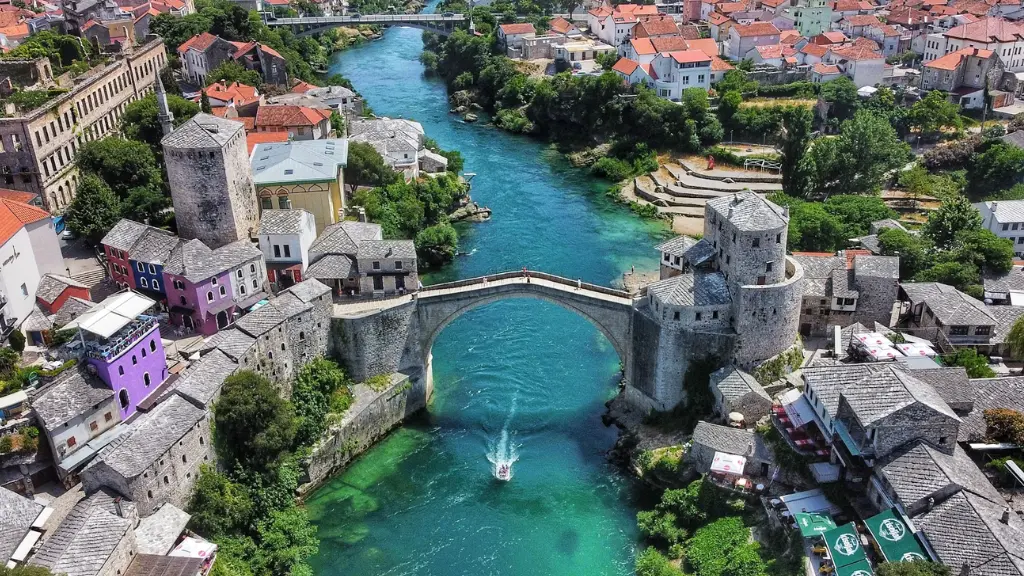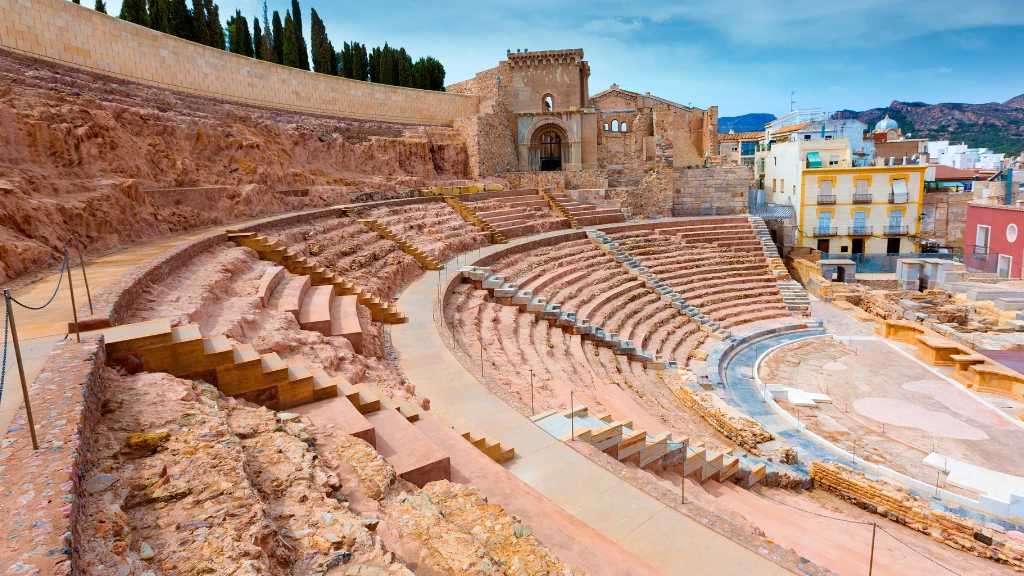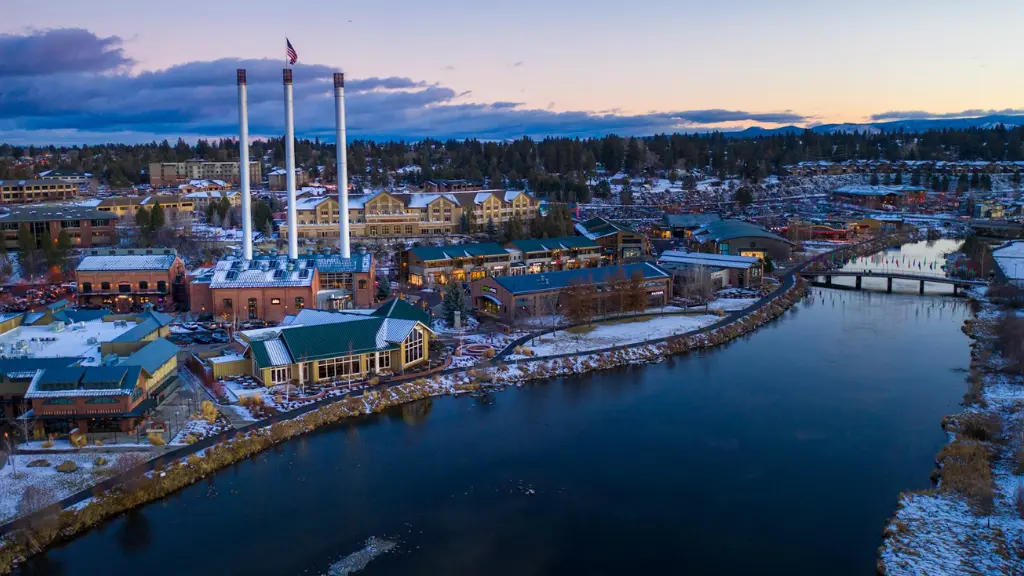Nestled in the heart of Bosnia and Herzegovina, the city of Mostar offers a unique blend of history, culture, and architectural charm. The city’s crown jewel, Stari Most (Old Bridge), is more than just a bridge; it’s a symbol of resilience, history, and unity that has captivated travelers from all over the world. Crossing the Neretva River, Stari Most connects two sides of Mostar and centuries of tradition, making it an iconic landmark that draws visitors into its rich story.
Here’s everything you need to know about Mostar’s famous Stari Most and why it’s worth a place on your travel itinerary.
You May Also Like: Manhattan’s First Korean Food Hall is Opening Next Summer
1. The History of Stari Most: A Bridge Built on Unity and Innovation
Stari Most was built in 1566 during the Ottoman Empire and designed by Mimar Hayruddin, a celebrated student of the famous architect Mimar Sinan. This bridge was no ordinary construction; it was a feat of engineering marvel for its time. Standing 78 feet tall and stretching over 95 feet across the Neretva River, it was the longest single-arch bridge in the world when it was completed.
The bridge served as a vital connection between the two banks of Mostar, bridging not only a river but also communities and cultures. For centuries, Stari Most was a symbol of peaceful coexistence and an architectural wonder that represented Mostar’s vibrant cultural diversity.
Image Ideas: Old archival images of Stari Most, artistic rendering of the bridge construction, Ottoman-era artwork featuring the bridge
2. The Bridge’s Destruction and Remarkable Reconstruction
Tragically, in 1993, during the Bosnian War, Stari Most was destroyed. This loss was more than just a physical blow; it severed a historical and symbolic link between communities and generations. However, thanks to international support and extensive efforts by UNESCO, the bridge was rebuilt in 2004, following original blueprints to preserve its historical accuracy.
The reconstruction used stones from the original quarry, and the rebuilt Stari Most once again became a symbol of unity and resilience. In 2005, Stari Most was declared a UNESCO World Heritage site, marking its place as a cultural and historical icon for Bosnia and Herzegovina.
Image Ideas: Images of the destroyed bridge in 1993, workers rebuilding Stari Most, the UNESCO ceremony marking the bridge’s new era
3. The Diving Tradition of Stari Most: An Adrenaline-Fueled Rite of Passage
One of the unique aspects of Stari Most is its diving tradition. Local young men have been diving off the bridge for centuries as a coming-of-age ritual, showcasing their courage and skill. Today, the tradition lives on, and each year, divers from around the world come to Mostar to participate in the Red Bull Cliff Diving World Series, where they leap from Stari Most’s 78-foot height into the Neretva River below.
If you’re visiting during the diving season, watching these daring jumps from the bridge is a thrilling experience. For those who want to try it, diving off Stari Most is now available to visitors – if they complete proper training and earn their certificate from the local diving club.
Image Ideas: Local divers in mid-jump, crowd gathered to watch the annual diving competition, diver plunging into the river with the bridge in the background
4. Architectural Beauty and Ottoman Influence
Stari Most’s unique design is a testament to Ottoman architecture, reflecting the elegance and grandeur of the era. The bridge’s single-arch design creates a beautiful symmetry, mirrored by the blue waters of the Neretva River, creating a stunning visual display, especially during sunset.
The stone towers, Tara and Halebija, stand guard on either side of the bridge, adding to its fort-like charm. Walking across Stari Most is like stepping into the past, where the structure itself speaks of ancient skills and artistry, evoking a time when Mostar was a thriving center of culture and commerce.
Image Ideas: Close-up of the arch structure, view of the bridge from the river, sunset views reflecting the bridge in the water
5. Exploring Mostar: Beyond the Bridge
While Stari Most is undoubtedly the main attraction, Mostar is a city full of other treasures. The Old Bazaar, located just steps away from the bridge, offers a lively atmosphere with local shops, traditional handicrafts, and authentic Bosnian cuisine. The Koski Mehmed Pasha Mosque, another Ottoman-era architectural marvel, provides a breathtaking panoramic view of Stari Most and the Neretva River from its minaret.
For a quieter experience, head to the Crooked Bridge (Kriva Cuprija), a miniature version of Stari Most built before the main bridge and thought to be its prototype. Wandering through Mostar’s cobblestone streets is like exploring an open-air museum filled with history, culture, and a peaceful ambiance.
Image Ideas: Mostar’s Old Bazaar, Koski Mehmed Pasha Mosque and its view, Crooked Bridge nestled among buildings
6. Stari Most as a Symbol of Peace and Reconciliation
Stari Most holds a deep meaning for many, representing peace and reconciliation in a region that has experienced division and hardship. Its destruction during the war and subsequent reconstruction have made it a monument of resilience and hope, resonating with locals and tourists alike. Visiting Stari Most is not just about seeing a historic landmark; it’s about understanding the spirit of Mostar and its people.
This historic bridge has brought people together for generations, and today, it stands as a testament to Bosnia’s enduring strength. The Stari Most story is a reminder that even after destruction, beauty and unity can be restored.
Image Ideas: Local people gathering on the bridge, peaceful river scenes below, images of local families and tourists admiring the view from Stari Most
7. Tips for Visiting Stari Most
If you’re planning a trip to Mostar to see Stari Most, here are a few tips to make the most of your visit:
- Best Time to Visit: Late spring through early fall (May to September) is ideal for comfortable weather and vibrant local activities. Visiting in July or August will also give you the chance to witness the annual diving competitions.
- Photography Tips: Early morning or late evening offers the best lighting for capturing Stari Most in its full glory. The bridge is especially picturesque when viewed from the riverbank or nearby cafes.
- Walking Tour: Joining a guided tour can enhance your experience with historical insights about the bridge and Mostar’s heritage.
- Respect Local Traditions: If watching the diving, stay on designated areas and avoid standing too close to divers. Respecting local customs and traditions makes for a positive visit.
Image Ideas: View of Stari Most during sunrise or sunset, diving competition crowd, local guide sharing history with visitors
Why Stari Most Should Be on Your Travel List
For travelers looking for a blend of culture, history, and breathtaking views, Stari Most in Mostar is a destination that delivers on all fronts. The bridge embodies centuries of architectural brilliance and cultural heritage, offering a unique look into the soul of Bosnia and Herzegovina. From its historic construction to the daring diving tradition, Stari Most is more than a landmark – it’s a living story of resilience and unity that will captivate anyone who visits.
Whether you’re strolling through Mostar’s cobbled streets, marveling at Ottoman architecture, or watching a diver plunge into the Neretva, Stari Most offers an experience that’s both visually stunning and deeply meaningful. Don’t miss out on this historic gem when you’re in Bosnia!










